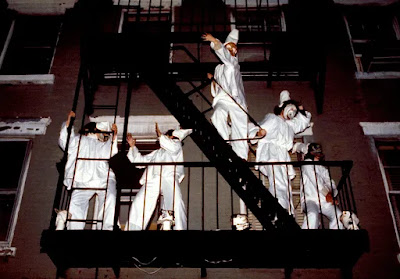Annamaria on Monday
Antescript: I wrote this post before the news broke of those poor young people in South Korea who perished during a Halloween celebration gone haywire. My sympathies are with their families and their nation. Of all the plagues facing our poor beleaguer planet, no one seems to worrying much about the dangerous combination of youth and alcohol. It's a subject that bears discussion. I will save that for another day. And go ahead for now with what I had prepared for my post on Halloween 2022.
This is a tale of life in Greenwich Village NYC in the 1970s. It was a fascinating place to be - one of the epicenters of the counter culture. I moved here in 1973 to be in the district for PS 3, where I enrolled my five-year-old daughter. Also in that school district were Westbeth and the artist-occupied lofts further downtown (long before the zone was renamed Soho and became the precinct of lawyers and their billionaire clients.) Westbeth was a group of buildings, formerly Bell Labs, then given over to artists of all sorts - painters, dancers, musicians. The heroes of this story are the puppet-makers who lived there.
I wanted PS 3 for my daughter because of its progressive philosophy. Kids were not lock-stepped into grade levels by age, but grouped with kids of different ages--K-1, K-1-2, 1-2-3, etc. based on their learning levels. Here is what the NYC Public School website says about its history:
The PS 3... came into being through a community workshop process known as a ‘charrette,’ at which parents and other community members, teachers, administrators, public officials, social planners and educational consultants arrived at a vision of child-centered learning in open multi-age classrooms, with a nonhierarchical structure, active parent involvement and an emphasis on the arts. John Melser, an educator from New Zealand, served as the school’s first leader.
The student body came from all sorts of homes: well-known writers, artists from Westbeth and those loft that were barely more than cleaned up abandoned factory floors. In 1974, when Kerry Ann was just starting first grade, the puppeteer and mask maker, Ralph Lee had the wonderful idea of a Halloween Parade, featuring his huge and gorgeous puppets and including the school children.
The neighborhood at the time was a welcoming enclave for gay people, who also joined in the fun.
In those first few years, the Westbeth artists and the parents of PS 3 were the major organizers. An NYPD officer on a motorcycle led the marchers along the narrow local streets, lined with townhouses and apartment buildings of no more than five or six stories.
People inside the apartments often dressed up in their own costumes and participated from the fire escapes outside their windows. I wish I had a photo of the group who dressed up as the cast of the then Broadway hit Evita, all looking incredibly authentic and lip-synching to the cast album blaring from their phonograph.
The parade ended in Washington Square Park where prizes were offered to children with the best costumes and candy treats for all.
Our family loved the event so much that each year we had a dinner party that began with hors d'oeuvres before the march and the main course and dessert afterwards. As word of the lovely parade got out, the crowd grew in the following years, but the event remained a neighborhood party.
Eventually, though, it got taken over. Promoters from outside the neib saw dollar signs, secured the parade permit ahead of those who had normally gotten it. Alacazam! It suddenly became a televised extravaganza, with lots of commercials - an event too big for the local streets.
Wherever you are in the world, you can probably see it on TV tonight, filling up broad Sixth Avenue, and garnering profits. It still does one of the things the neighborhood parade did from the beginning - demonstrating in the costumes and tableaus the creativity of ordinary people.
As for me, I am really happy that I and mine were there for the oh so sweet beginning.




























.png)





































